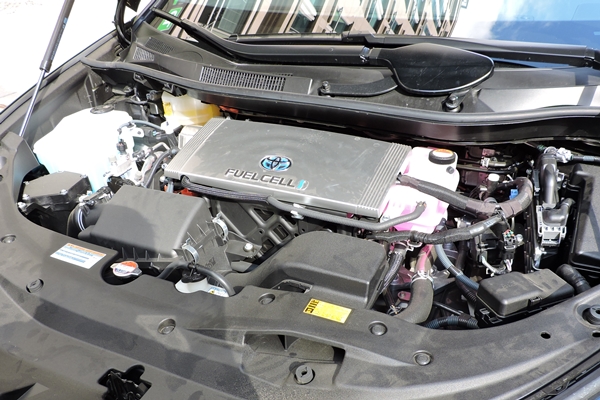5 October 2016. As the first hydrogen fuel cell vehicles go on sale, a group of companies and government agencies are seeking ways to encourage sales to help meet national goals for reducing greenhouse gases. The U.S. Department of Energy (DoE) is supporting the effort with a new $30 million program to advance fuel cell technologies that bring down the cost of fuel cells for transportation.
Hydrogen fuel cells work something like batteries, with negative and positive electrodes, or anodes and cathodes, surrounded by an electrolyte. Hydrogen fuel is fed into the anode, and air into the cathode, with a catalyst, usually platinum, separating the hydrogen into protons and electrons. Electrons are directed to an external circuit, where the electric current is captured. Protons travel through the electrolyte to the cathode, where they join with oxygen and electrons to form water and heat. No carbon dioxide or other greenhouse gases are produced with fuel cells.
David Friedman, DoE’s acting Assistant Secretary for Energy Efficiency and Renewable Energy, announced the new funding at a Washington, D.C. news conference in advance of National Hydrogen and Fuel Cell Day that occurs on Saturday, 8 October. The department also released a report showing industry produced and shipped some 60,000 fuel cells worldwide generating more than 300 megawatts of energy, a gain of 65 percent compared to 2014. The year 2015 also marked the first commercial shipments of fuel cell vehicles, mainly in California, parts of Europe, and Japan.
Auto industry executives at the meeting described the first vehicles reaching the market: the Hyundai Tucson sport utility vehicle and Toyota Mirai, a four-door sedan. The Honda Clarity, another four-door sedan, is expected to be released in a few months. The vehicles travel 268 to more than 300 miles on a single tank of hydrogen fuel, can refill in 3 to 5 minutes, and early adopters note that driving and handling of fuel cell vehicles is similar to cars with internal combustion engines.
The industry representatives noted the importance of establishing hydrogen fueling stations before trying to sell fuel cell vehicles to the public. First Element, a start-up enterprise in Newport Beach, California, established 23 hydrogen fueling stations in California, where makers of fuel cell vehicles are introducing their first models. Joel Ewanick, First Element’s chairman and CEO, told the news conference that another 25 stations are planned in the state. He said the network of stations can now support 5,000 to 6,000 vehicles.
At the meeting, Ewanick described the business environment for hydrogen stations as “a marketing challenge, not an engineering challenge.” To demonstrate the feasibility of travel by fuel cell vehicles, he and associates drove more than 1,400 miles last month through California and Nevada, facing no refueling issues during the trip. Ewanick noted, however, “Hydrogen is still too expensive. We need to bring it down to the price of gasoline.”
The auto industry executives acknowledged that the price of fuel cell vehicles themselves is competitive, but still needs to come down as well. The Toyota and Honda sedans have suggested retail prices of $57,000 and $60,000 respectively. An industry-government consortium called H2USA aims to support the further development of hydrogen fuel cell vehicles, including the fueling infrastructure, to build economies of scale for both vehicles and fueling stations.
The new DoE financing also aims to bring down the cost of fuel cell vehicles. The new funds will support research and development of advanced materials to replace platinum as the catalyst in fuel cells, accelerate discovery of advanced water-splitting materials to produce hydrogen, and resolve outstanding issues in storing hydrogen in vehicles, including development of low-cost, strong precursors of carbon fibers for hydrogen storage.
October 8 is designated as National Hydrogen and Fuel Cell Day, since the numerical date — 10.08 — is similar to the atomic weight of hydrogen, 1.008.
Read more:
- Inexpensive Hydrogen Storage Devised for Solar Energy
- U.S. Energy Use Declines in 2015, Renewables Gain
- What it Takes to Innovate in the Old Economy
- Governments, Private Investors Unveil Clean Energy Plans
- ARPA-E Funding 41 Energy Generation, Efficiency Projects
* * *



 RSS - Posts
RSS - Posts
You must be logged in to post a comment.